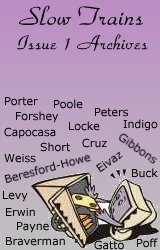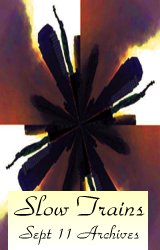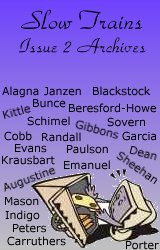
Turning Green in Ecuador
by David A. Taylor
It was getting dark in the Andes and the conductor -- the only person in the world who knew where we needed to get off -- was dozing in the stairwell of the bus. The driver had no clue that my wife and I had to get off at the remote village of Rio Verde. Lisa and I had no idea what Rio Verde looked like, we only knew it was tiny and had a church. (I looked closely at each church we passed, as if the right one would tell me.) No, the only person who knew both pieces of the puzzle was nodding off, propped by his elbows against the front of our seat. His head jerked up once, again, then sank for good.
I finally nudged him. “¿El Otro Lado?” I said. He grumbled and waved further down the road.
6:15. That was the time that Lisa and I had determined was the latest we could reach Rio Verde, start down the 20-minute winding path to the lodge El Otro Lado and not get bushwhacked by darkness. We’d been warned that we didn’t want to be on the path after dark. After 6:15, it would be better just to stay on the bus into the next city.
Just then the conductor jerked awake and barked, “El Otro Lado.”
The Other Side. We stepped down onto dust, the road forever under construction. At the rear compartment the conductor unearthed our bag from under an ashen mountain of army duffles. A sign pointed down a steep slope. Far down in the valley, amid the darkening treetops, we could see a metal roof that might be the lodge where we were headed.
I hadn’t come to Ecuador for ecotourism. We couldn’t afford the trip to the Galapagos, and I didn’t even want to go to the jungle lodge that my cousin worked with. The Amazon, I thought, was overhyped. I just wanted to walk in the Andes and not be at the mercy of river guides. Frankly, I’m suspicious of ecotourism. It’s a booming industry touted for its potential to help the environment and local economies, but I know of just a handful of places where locals have gotten anything out of it and outsiders haven’t run roughshod over them. In extreme cases like the Kuna community on Panama’s coast, locals had to burn down hotels to reclaim their homes.
Yet despite my aversion I had ended up at Yachana Lodge, the ecolodge where my cousin worked on the Rio Napo. Now we were making the arduous trip from there into the mountains, and the quiet lodge of El Otro Lado. Neither Lisa nor I spoke Spanish.
“What are we doing in the middle of South America?” she said at one point. I couldn’t think of a good answer.
Douglas McMeekin, founder of Yachana Lodge, knew why he was in Ecuador: bankruptcy. At least, declaring bankruptcy in the U.S. during the 1980s, when his real estate business went flat, forced him to reassess his life. The fifty-something gentleman from Kentucky said it was liberating, “although it didn’t feel that way at the time.”
He went to Ecuador and advised oil companies on how to meet their obligation to foster local development. After a few years, he figured he could do better on his own. He started Yachana Lodge as a centerpiece of his foundation called FUNEDESIN. With donated equipment they opened a clinic in October 1997 to serve a 25-mile stretch of the Rio Napo, Amazon headwaters in what’s known as Ecuador’s Oriente region.
“Now I’m doing what I want to do,” McMeekin said. “Before, I wasn’t.”
The lodge was a two-hour canoe ride from the nearest roadhead, plus several bus connections from Quito. One of those buses didn’t have working windshield wipers, so during one downpour the driver was peering at blurry shapes through a kind of glaze. As we sluiced downriver in the dugout, the lodge appeared on the right bank. Its dorm-style rooms and cabins were rustic but clean, made of light wood and thatch. We got one of the ‘family-style’ cabins. Meals (mostly vegetarian) were served in the dining room, where guests sat on hard benches donated by a Quito pizzeria. Yachana offered guided walks in the rainforest, visits to its local health clinic and permaculture farm, and a chance to soak up Amazonian sounds and smells.
The people who live nearby eke out a living growing coffee and cacao (the source of chocolate). McMeekin doesn’t approve of some of their ways, like cattle-raising, but he’s not blind to their dilemmas either. He said Yachana’s aim was to give those who live in the forest help in creating a better future. He likes to tell a story about when villagers were asked to sketch the past, present and future of their area. The past and present drawings followed the same pattern of facts, but the futures varied widely. In many drawings, the forest was leveled. One sketch was divided into a hundred plots of land; at the bottom of the page people were fighting. With efforts like the clinic and a food-processing enterprise that makes jellies from forest fruits, McMeekin hoped to inject a ‘can-do’ spirit into the area. There was a kind of outward-bound hardiness among the staff: the showers were solar-heated and the cabins lit by kerosene lamps.
Showers in the morning were ice cold.
After breakfast of fried eggs over green banana frites, we pulled on knee-high rubber boots to walk to the clinic. While we inspected the dentist’s chair and the surgery, a patient showed up: a small boy escorted by his two older brothers. The most common local complaints, the nurse said, were respiratory problems, parasites and leishmaniasis, a nasty disease transmitted by sandflies. That morning the folks in the Yachana food center nearby were cooking up rainforest jam in their new double-boiler, which swirled hot oil around the outside of a passion-fruit/papaya mix. They tossed in lemon rind to test its effect. If the jelly business from wild fruits of the forest takes off, the income could help encourage locals to preserve their forest rather than cut it to make room for cattle pasture.
But sometimes it seemed that things at Yachana were more to satisfy the idiosyncrasies of the staff than the needs of locals. Later we crossed the river to check out the Yachana farm. Miguel, our guide, gave a brief introduction in English about how we can learn about farming from the plants and animals that are native in a place. That made sense. Then the conversation switched to Spanish and Miguel’s explanations got faster and faster, almost giddy.
“I think he’s manic,” my cousin said. Before long, Miguel was posing his work on the farm as a battle against local ignorance and destruction.
I asked Douglas, “What do the farmers think of this?”
“They think we’re nuts,” he said.
The afternoon was turning dark by the time Miguel led us from the farm tour into the rainforest, past massive trees with huge, tendoned roots. Miguel was overjoyed. He picked up a round fruit, split open in sections, and asked one lodge guest—a big German in fatigues— for his jackknife. Miguel sliced off the tips and showed how you could press the fruit against your t-shirt for natural tie-dye; then he offered a tie-dye circle to others. One European woman accepted one on her shirt over her stomach. Miguel pressed the fruit there, then pulled it away, leaving a perfect rainbow circle of color. He was giggling maniacally. I felt like we were following a visionary artist like Howard Finster into the rainforest, with all the safety that implied (none). It got darker. We met with a four-year-old boy collecting slugs in a pouch he made from his shirt front. Miguel filched several large ones and demonstrated how to eat them live. He held one between his teeth, the free end wriggling, and laughed for a tourist’s camera flash. He invited the European woman to bite the other end. The little boy looked on without a word.
We finally turned back when we came to a stream that blocked our path. “It’s going to rain,” Miguel said abruptly. He let us take a wrong turn, before getting us back to the river at a fast clip. As we shoved off from the shore to return across the river, the rain made the whole scene a blur of gray, and drenched us. Miguel slumped sullenly under the bow.
Our last morning at Yachana, Douglas asked our opinion of the coffee, the first batch they’d roasted themselves. It tasted bitter and Lisa told him so. He looked irritated. Still, he offered us a ride to Tena, the nearest town with a bus depot where we could set off for El Otro Lado.
On the ride to Tena I asked Douglas what Yachana meant. “It’s a Quechua word,” he said. “It means ‘place of learning'. That’s what we’re doing.” Just then a one-two punch of water balloons exploded against the car windows: first from the right, then one from the left. For the weeks before Fat Tuesday in February, dousing innocents with water is a favorite sport. The kids must have been standing there for ages waiting for a car to pass. We rolled up the windows.
The rest of the day was a blur of Tena’s heat, more ritual dousings by eight-year-olds, and a bus packed to the gills, with a woman in a print dress struggling to sit lady-like on the hump of the transmission next to the driver. Every town we pass looked derelict and the end of the world.
Then dusk settled, the conductor ushered us off the bus. It was time to find El Otro Lado. Pronto. We had booked our stay
at El Otro Lado with a travel agent; the photos and description suggested a secluded lodge with few pretensions in the Andean foothills. But here, signage was minimal; we had to get there before dark.
After ten minutes hoofing it down the slope we reached a flimsy suspension bridge wet with spray from a pounding waterfall that we could almost reach out and touch. We lurched across it with a mixture of fear and wonder, into even darker woods. More hiking and anxiety and finally we came to a clearing with blooming impatiens and a lamp in a doorway.
“¡Hola!” Lisa called out. “Tiene una reservation.”
“Yes, you do,” said a dark-haired young woman. She introduced herself as Sefan.
She offered us lemonade. A tape of classical music gave the cabaña the feel of a sophisticated commune. It felt very welcoming. Sefan and her partner Pierre were our hosts, both from France and sitting in for the lodge’s owners, who were in Israel for several months. Pierre took a flashlight and showed us to our own cabaña: it was airy, with a thatched roof and a black mosquito net strung above the bed. A gas-powered hot-water shower and toilet were in a hut to the side. We even had two electric lights. The place had a rustic feeling, but with more sophistication and flair than Yachana’s Spartan sensibility, something like the world-traveler haunts in places like Thailand. Of course, part of that feeling came because the owners of El Otro Lado had hooked into the nearby town’s power grid (the line seemed to vanish up the side of the valley, into the mist).
I really enjoyed my hot shower that night.
Afterward, waiting for dinner, we sat with a photo album of El Otro Lado’s origins. It showed that the owners’ pioneering efforts, like at Yachana, included an attempt to make a micro-hydro generator for self-sufficiency. Before and after photos of their land showed how much the local forest cover had recovered from its deforested past. And over the cozy meal of black beans cooked in beer, carrot salad and broccoli, Pierre and Sefan described their experiments with organic gardening. Dessert included a local fruit coulis. Talk about style.
So which was better? El Otro Lado had a pleasant style but felt more remote from the locals. Yachana was engaged in local affairs but felt a little too earnest, a little rough with missionary zeal.
Our one experience with a locally run ecoventure came the next day, near El Otro Lado, when we hiked back to the fearsome waterfall we’d seen, El Paillon del Diablo. We found a wooden gate across the path and a sign saying the same family had owned the land since 1945. It requested donations “for upkeep of the path and nature, maximum 7 persons at a time.” It regulated access, explained the history, we were satisfied. We gave our coins to the woman as she worked on her embroidery, and she let us pass.
©2001 by David A. Taylor





